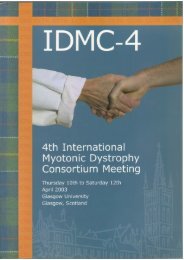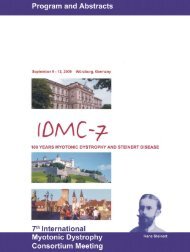Create successful ePaper yourself
Turn your PDF publications into a flip-book with our unique Google optimized e-Paper software.
Abstract No : 16<br />
ORAL PRESENTATIONS<br />
A REVERSIBLE MULTISYSTEMIC MURINE MODEL<br />
OF MYOTONIC DYSTROPHY TYPE 2<br />
Margolis J.M., Kang Y.L., Zu T., Day J.W. and Ranum L.P.W.<br />
MMC 206, 420 Delaware St. SE, University of Minnesota, Minneapolis, MN 55455, USA<br />
We previously showed that <strong>myotonic</strong> <strong>dystrophy</strong> type 2 (DM2) is caused by a large CCTG<br />
repeat expansion in intron 1 of the zinc finger protein 9 (ZNF9) gene. There is growing<br />
evidence that DM1 and DM2 are caused by an RNA gain of function mechanism in which<br />
the CUG and CCUG expansions cause the multisystemic features of these diseases by<br />
directly altering RNA processing. To investigate the role that expression of the CCUG<br />
transcripts play in the multisystemic DM phenotype, and to avoid problems such as<br />
infertility that have complicated previous systemic models of DM1, we have developed<br />
a tetracycline inducible murine model of the DM2 CCUG expansion. In our expansion<br />
lines, the expression of a CCTG repeat tract with 300 repeats is driven by a tet-responsive<br />
(TRE)/minimal CMV promoter as part of a non-coding transcript. These TRE-CCTG<br />
expansion lines have been crossed to tet-activator (tTA) mice in which the tTA is controlled<br />
by a CMV promoter. Doubly transgenic mice TRE-CCTG / CMV-tTA mice ubiquitously<br />
express CCUG expansion transcripts in the absence of doxycycline. Routine H&E staining<br />
of muscle from these doubly transgenic animals shows variation in fiber size and<br />
centrally located nuclei indicative of myopathy. Additionally, skeletal muscle shows<br />
ribonuclear inclusions and aberrant splicing of the insulin receptor (IR) by RT-PCR analysis,<br />
which has not previously been reported in mouse models of DM1. Like DM1 and DM2<br />
patient biopsies, the predominant IR isoform in muscle from these mice excludes exon<br />
11 which leads to a preferential expression of the insulin insensitive isoform. Further,<br />
aberrant splice patterns of cTNT are observed by RT-PCR from cardiac muscle indicating<br />
that the CCUG expansion transcripts in this model affect both cardiac and skeletal muscle.<br />
In a separate series of experiments the TRE-CCUG expansion lines described above<br />
will be crossed to two different BAC transgenic lines engineered to drive expression of<br />
the tTA using the endogenous human DMPK or ZNF9 promoters. Phenotypic characterization<br />
of these doubly transgenic mice will help determine the extent to which the clinical<br />
similarities and differences, including developmental differences between DM1 and<br />
DM2, result from differences in the temporal and spatial expression patterns of the<br />
repeat containing transcripts driven by the ZNF9 and DMPK promoters.<br />
QUEBEC 2005 37




